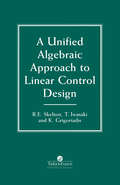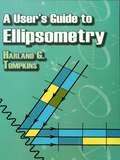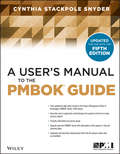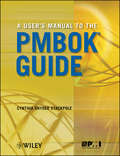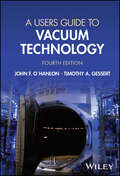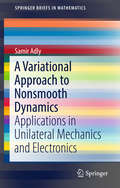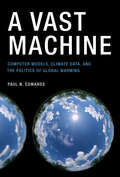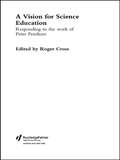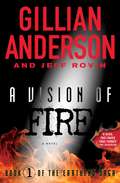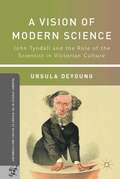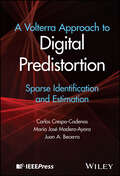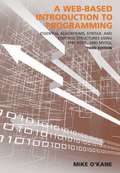- Table View
- List View
A Unified Algebraic Approach To Control Design
by DimitriE. GrigoriadisThis text deals with the most fundamental deficiency of modern theory control: the lack of an easily applicable method for the design of low order controllers. It shows that solutions to many different problems in control all reduce to the same linear algebra problem. It employs matrix equalities and matrix inequalities in the solutions of fixed order control and also provides computational algorithms.
A Unifying Framework for Formal Theories of Novelty: Discussions, Guidelines, and Examples for Artificial Intelligence (Synthesis Lectures on Computer Vision)
by Terrance Boult Walter ScheirerThis book presents the first unified formalization for defining novelty across the span of machine learning, symbolic-reasoning, and control and planning-based systems. Dealing with novelty, things not previously seen by a system, is a critical issue for building vision-systems and general intelligent systems. The book presents examples of using this framework to define and evaluate in multiple domains including image recognition image-based open world learning, hand-writing and author analysis, CartPole Control, Image Captioning, and Monopoly. Chapters are written by well-known contributors to this new and emerging field. In addition, examples are provided from multiple areas, such as machine-learning based control problems, symbolic reasoning, and multi-player games.
A Universe Big & Small: A Story About Carl Sagan
by James YangGeisel Award–winning creator James Yang explores the mysteries of the universe, inspired by the work of lauded astronomer Carl Sagan.When Carl stared out the window, he had many questions.Astronomer and scientist Carl Sagan loved asking questions—he wanted to learn about everything from the smallest atoms to the vastness of the galaxy. And by using his imagination and allowing himself to dream up questions big and small, he inspired others to keep exploring the mysteries of the universe and our place in it.Geisel Award-winning author and illustrator James Yang invites readers on a fantastic journey through the cosmos, inspired by the life and work of Carl Sagan.
A User's Guide to Ellipsometry (Dover Civil and Mechanical Engineering)
by Harland G. TompkinsThis text on optics for graduate students explains how to determine material properties and parameters for inaccessible substrates and unknown films as well as how to measure extremely thin films. Its 14 case studies illustrate concepts and reinforce applications of ellipsometry -- particularly in relation to the semiconductor industry and to studies involving corrosion and oxide growth.A User's Guide to Ellipsometry will enable readers to move beyond limited turn-key applications of ellipsometers. In addition to its comprehensive discussions of the measurement of film thickness and optical constants in film, it also considers the trajectories of the ellipsometric parameters Del and Psi and how changes in materials affect parameters. This volume also addresses the use of polysilicon, a material commonly employed in the microelectronics industry, and the effects of substrate roughness. Three appendices provide helpful references.
A User's Guide to the Age of Tech (Electronic Mediations)
by Grant WythoffHow users experience and influence technological change—when so much of that change feels out of our control Every day, we casually employ one of the most complex tools ever created, using it to read the news, plan our day, and connect with friends. In A User&’s Guide to the Age of Tech, Grant Wythoff investigates the process by which now-ubiquitous technologies like our phones become integrated into our lives, showing how the &“gadget&” stage—before devices are widely adopted—opens the door for users to co-create these technologies and adapt them toward unexpected ends. In this elegant, approachable work, Wythoff offers a view of how users make new technology their own, subverting dominant power structures and imagining uses never intended by their creators. Rooted in a detailed look into the history of technique (focusing on how we do things with tools rather than the tools themselves), A User&’s Guide to the Age of Tech proceeds to complicate, and influence, discussion of subjects like the digital divide and AI. Drawing on a range of sources, including novels, patents, and newspapers, Wythoff explores the vernacular philosophies that have emerged from users and their diverse, everyday practices, bringing down to earth the conversation about digital titans, away from the abstracted domains of server farms and algorithms. Lodging a passionate argument that we know ourselves better than the data brokers who appear to wield influence over our psyches, Wythoff invites readers (and tech users) to imagine their own digital technique, acknowledge their vast expertise, and see its immense value. Retail e-book files for this title are screen-reader friendly with images accompanied by short alt text and/or extended descriptions.
A User's Manual to the PMBOK Guide
by Cynthia Snyder StackpoleThe must-have manual to understand and use the latest edition of the Fifth Edition The professional standard in the field of project management, A Guide to the Project Management Body of Knowledge (PMBOK® Guide—Fifth Edition) published by the Project Management Institute (PMI®) serves as the ultimate resource for professionals and as a valuable studying and training device for students taking the PMP® Exam. A User's Manual to the PMBOK® Guide takes the next logical step to act as a true user's manual. With an accessible format and easy-to-understand language, it helps to not only distill essential information contained in the PMBOK® Guide—Fifth Edition, but also fills an educational gap by offering instruction on how to apply its various tools and techniques. This edition of the User's Manual: Defines each project management process in the PMBOK® Guide—Fifth Edition, describes the intent, and discusses the individual ITTOs (inputs, tools and techniques, and outputs) Features examples, handy tips, and sample forms to supplement learning Contains a data flow diagram of each process in the PMBOK® Guide—Fifth Edition to show how information is distributed Is updated to provide deeper coverage of stakeholder management and to include new processes for scope, schedule, cost, and stakeholder management The User's Manual enables you to put the PMBOK Guide—Fifth Edition to work on your projects. It will help you implement the processes described in the PMBOK Guide—Fifth Edition and apply the tools and techniques to help make your projects successful. Thorough in coverage and rich in content, it is a worthy companion to augment the important strategies laid out in the PMBOK® Guide—Fifth Edition, and the one book that aspiring or professional project managers should never be without. Fully updated to align with A Guide to the Project Management Body of Knowledge (PMBOK® Guide)–Fifth Edition Describes how to apply tools and techniques for projects and how to create process outputs Presents information by process group Expands upon the PMBOK® Guide with information on the sponsor's role and planning loops Integrates and describes interpersonal skills into the process where they are identified (PMBOK, PMI, PMP and Project Management Professional are registered marks of the Project Management Institute, Inc.)
A User's Manual to the PMBOK Guide
by Cynthia StackpoleThe professional standard in the field of project management, A Guide to the Project Management Body of Knowledge better known as the PMBOK® Guide published by the Project Management Institute (PMI) serves as the ultimate resource for professionals and as a valuable studying and training device for students taking the PMP® exam. A User's Manual to the PMBOK® Guide takes the next logical step to act as a true user's manual. Its accessible format and easy-to-understand language helps to not only distill essential information contained in the PMBOK® Guide--Fourth Edition, but also fills an educational gap by offering instruction on how to apply its various tools and techniques. This book: * Defines each project management process in the PMBOK® Guide--Fourth Edition, describes their intent, and discusses their individual ITTOs (inputs, tools and techniques, and outputs) * Features examples, handy tips, and sample forms to supplement learning * Is written by the author who was project manager of the PMBOK ®Guide--Fourth Edition * Contains a data flow diagram of each process in the PMBOK® Guide--Fourth Edition to show how information is distributed A User's Manual to the PMBOK® Guide simplifies the PMBOK® Guide--Fourth Edition to provide the springboard from which successful project management processes are interpreted and carried out in the real world. Thorough in coverage and rich in content, this manual is a worthy companion to augment the important strategies laid out in the PMBOK® Guide Fourth Edition--and the one book that aspiring or professional project managers should never be without.
A Users Guide to Vacuum Technology
by John F. O'Hanlon Timothy A. GessertA USERS GUIDE TO VACUUM TECHNOLOGY Choose and understand the vacuum technology that fits your project’s needs with this indispensable guide Vacuum technology is used to provide process environments for other kinds of engineering technology, making it an unsung cornerstone of hundreds of projects incorporating analysis, research and development, manufacturing, and more. Since it is very often a secondary technology, users primarily interested in processes incorporating it will frequently only encounter vacuum technology when purchasing or troubleshooting. There is an urgent need for a guide to vacuum technology made with these users in mind. For decades, A User’s Guide to Vacuum Technology has met this need, with a user-focused introduction to vacuum technology as it is incorporated into semiconductor, optics, solar sell, and other engineering processes. With an emphasis on otherwise neglected subjects and on accessibility to the secondary user of vacuum technology, it balances treatment of older systems that are still in use with a survey of the latest cutting-edge technologies. The result promises to continue as the essential guide to vacuum systems. Readers of the fourth edition of A User’s Guide to Vacuum Technology will also find: Expanded treatment of gauges, pumps, materials, systems, and best??operating practices Detailed discussion of cutting-edge topics like ultraclean vacuum and contamination control An authorial team with decades of combined research and engineering experience A User’s Guide to Vacuum Technology is essential for those entering emerging STEM programs, engineering professionals and graduate students working with a huge range of engineering technologies.
A Vaccine Is Like a Memory
by Rajani LaRoccaThis timely book details the importance of vaccines and how they were developed throughout history, as well as how they work to protect your body and keep it healthy.Do you remember every time you've been sick?You may not, but your body does! With many illnesses, you can't get sick more than once because your body remembers and fights it off before you get sick again. But what if your body could recognize germs that you've never had before so you don't get ill? There's where vaccines come in! This book comes complete with extensive back matter all about types of germs and vaccines.
A Variational Approach to Nonsmooth Dynamics
by Samir AdlyThis brief examines mathematical models in nonsmooth mechanics and nonregular electrical circuits, including evolution variational inequalities, complementarity systems, differential inclusions, second-order dynamics, Lur'e systems and Moreau's sweeping process. The field of nonsmooth dynamics is of great interest to mathematicians, mechanicians, automatic controllers and engineers. The present volume acknowledges this transversality and provides a multidisciplinary view as it outlines fundamental results in nonsmooth dynamics and explains how to use them to study various problems in engineering. In particular, the author explores the question of how to redefine the notion of dynamical systems in light of modern variational and nonsmooth analysis. With the aim of bridging between the communities of applied mathematicians, engineers and researchers in control theory and nonlinear systems, this brief outlines both relevant mathematical proofs and models in unilateral mechanics and electronics.
A Vast Machine: Computer Models, Climate Data, and the Politics of Global Warming (Infrastructures)
by Paul N. EdwardsThe science behind global warming, and its history: how scientists learned to understand the atmosphere, to measure it, to trace its past, and to model its future.Global warming skeptics often fall back on the argument that the scientific case for global warming is all model predictions, nothing but simulation; they warn us that we need to wait for real data, “sound science.” In A Vast Machine Paul Edwards has news for these skeptics: without models, there are no data. Today, no collection of signals or observations—even from satellites, which can “see” the whole planet with a single instrument—becomes global in time and space without passing through a series of data models. Everything we know about the world's climate we know through models. Edwards offers an engaging and innovative history of how scientists learned to understand the atmosphere—to measure it, trace its past, and model its future.
A View from the Wings: 60 Years in British Aviation
by Colin CruddasMany books have been produced which detail the lives and thoughts of famous individuals. A View from the Wings is unique, recalling a wartime boyhood in which aircraft flying constantly overhead played a large part. This experience led to a lifetime career in the aviation industry both in the UK and overseas such as the US and South Africa. Mixed with events of a more personal nature often coated with whimsical humour, the author has evocatively captured the rise and demise of Britain’s aircraft industry in the post-war period. In setting out to be non-technical, A View from the Wings will appeal to those whose memories embrace the sound barrier-breaking years and the leap of faith and technology that saw Concorde defeat the Americans in the race to produce a practical supersonic airliner. All too often political procurement and technical failures have made for dramatic headlines and these too are subjected to much critical comments. Think of the critically acclaimed Empire of the Clouds (Faber and Faber, 2010), but instead of a boyhood observer, the author was an active part of the British aviation industry in its former prime and eventual implosion.
A Vision for Environmental Sustainability: Overcoming Waste Management Challenges in Developing Countries (Environmental Science and Engineering)
by Maulin P. Shah Ashootosh Mandpe Sonam PaliyaThis book encapsulates numerous ideas for developing novel strategies toward sustainable waste management, incorporating technology transfer and capacity building for sustainable waste management, and enforcing the stringent policy framework for environmental protection from improper waste management practices. Sustainable waste management is a complex issue that is of increasing concern in developing countries. In these countries, waste management often faces significant challenges due to factors such as inadequate infrastructure, lack of funding and resources, and limited public awareness of the importance of waste management. However, there are also significant opportunities to improve waste management practices and create a more sustainable future. One of the major challenges of waste management in developing countries is inadequate infrastructure. Many developing countries lack the necessary infrastructure to properly manage waste, including landfills, recycling facilities, and waste treatment plants. This leads to significant environmental and health problems, including water pollution, soil contamination, and the spread of disease. This book is an essential resource for researchers and students studying solid waste management, waste valorization, biorefineries, biofuels/products/processes, as well as for geo-environmental engineers, biochemical/chemical engineers, and biotechnologists working in industries and government agencies, policymakers, conservationists, NGOs working for environment protection, etc. The authors are thankful to the contributors of these books for their cooperation and patience in the compilation of this task. The authors are also thankful to Springer team, for their constant support in the publication of this work.
A Vision for Science Education: Responding to Peter Fensham's Work
by Roger CrossOne of the most important and consistent voices in the reform of science education over the last thirty years has been that of Peter Fensham. His vision of a democratic and socially responsible science education for all has inspired change in schools and colleges throughout the world. Often moving against the tide, Fensham travelled the world to promote his radical ideology. He was appointed Australia's first Professor of Science Education, and was later made a Member of the Order of Australia in recognition of his work in this new and emerging field of study.In this unique book, leading science educators from around the world examine and discuss Fensham's key ideas. Each describes how his arguments, proposals and recommendations have affected their own practice, and extend and modify his message in light of current issues and trends in science education. The result is a vision for the future of science teaching internationally.Academics, researchers and practitioners in science education around the world will find this book a fascinating insight into the life and work of one of the foremost pioneers in science education. The book will also make inspiring reading for postgraduate students of science education.
A Vision of Fire: Book 1 of The EarthEnd Saga (The EarthEnd Saga #1)
by Jeff Rovin Gillian AndersonThe first novel from iconic X-Files star Gillian Anderson and New York Times bestselling author Jeff Rovin: a science fiction thriller of epic proportions.Renowned child psychologist Caitlin O'Hara is a single mom trying to juggle her job, her son, and a lackluster dating life. Her world is suddenly upturned when Maanik, the daughter of India's ambassador to the United Nations, starts speaking in tongues and having violent visions. Caitlin is sure that her fits have something to do with the recent assassination attempt on her father--a shooting that has escalated nuclear tensions between India and Pakistan to dangerous levels--but when teenagers around the world start having similar outbursts, Caitlin begins to think that there's a more sinister force at work. In Haiti, a student claws at her throat, drowning on dry land. In Iran, a boy suddenly and inexplicably sets himself on fire. Animals, too, are acting irrationally, from rats in New York City to birds in South America to ordinary house pets. With Asia on the cusp of nuclear war, Caitlin must race across the globe to uncover the mystical links among these seemingly unrelated incidents in order to save her patient--and perhaps the world.
A Vision of Modern Science: John Tyndall and the Role of the Scientist in Victorian Culture (Palgrave Studies in the History of Science and Technology)
by Ursula DeyoungAn examination of a pivotal moment in the history of science through the career and cultural impact of the historically neglected Victorian physicist John Tyndall,establishing him as an important figure of the period, whose scientific discoveries and philosophy of science in society are still relevant today.
A Visionary Nation: Four Centuries of American Dreams and What Lies Ahead
by Zachary KarabellIn this penetrating volume, Zachary Karabell examines the continuous thread that runs through the tapestry of the American experience -- the belief that we can create a perfect society -- and envisions what the next great era will be. Just as the Puritan vision of a city on a hill was supplanted by the Founding Fathers' vision of individuality, just as the expansive vision of a government-led Great Society was eclipsed by the New Economy of the 1990s, so too is the New Economy being replaced by what Karabell contends will be a period when community and spirituality occupy center stage.
A Visit to a Space Station: Fantasy Science Field Trips (Fantasy Science Field Trips Ser.)
by Claire ThropBooks in the Fantasy Field Trips series take the reader on field trips to the most unlikely of destinations! In this book, strap yourself in as we prepare to blast off to explore a space station far above the Earth's surface. Our 'tour' includes a look at daily life on board, how astronauts exercise, work and even go to the toilet, and how astronauts and their supplies are transported between Earth and the space station.
A Visit to the Recycling Center
by Tracy Vonder BrinkTravel through Rumpke’s recycling center to find a plastic jug? Trash that can be recycled takes a ride on the conveyor belt to become something new! Try to find the milk jug on the conveyor belt! Trash at the factory goes through many machines to make sure it can be recycled. Can you guess what the milk jug will help make once it leaves the factory? What other types of trash go on the conveyor belt?
A Voice in the Wilderness: A Pioneering Biologist Explains How Evolution Can Help Us Solve Our Biggest Problems
by Professor Joseph L Graves Jr.Why understanding evolution—the most reviled branch of science—can help us all, from fighting pandemics to undoing racism Evolutionary science has long been regarded as conservative, a tool for enforcing regressive ideas, particularly about race and gender. But in A Voice in the Wilderness, evolutionary biologist Joseph L. Graves Jr.—once styled as the &“Black Darwin&”—argues that his field is essential to social justice. He shows, for example, why biological races do not exist. He dismantles recent work in &“human biodiversity&” seeking genes to explain the achievements of different ethnic groups. He decimates homophobia, sexism, and classism as well. As a pioneering Black biologist, a leftist, and a Christian, Graves uses his personal story—his journey from a child of Jim Crow to a major researcher and leader of his peers—to rewrite his field. A Voice in the Wilderness is a powerful work of scientific anti-racism and a moving account of a trailblazing life.
A Volterra Approach to Digital Predistortion: Sparse Identification and Estimation
by Carlos Crespo-Cadenas Maria Jose Madero-Ayora Juan A. BecerraThorough discussion of the theory and application of the Volterra series for impairments compensation in RF circuits and systems A Volterra Approach to Digital Predistortion: Sparse Identification and Estimation offers a comprehensive treatment of the Volterra series approach as a practical tool for the behavioral modeling and linearization of nonlinear wireless communication systems. Although several perspectives can be considered when analyzing nonlinear effects, this book focuses on the Volterra series to study systems with real-valued continuous time RF signals as well as complex-valued discrete-time baseband signals in the digital signal processing field. A unified framework provides the reader with in-depth understanding of the available Volterra-based behavioral models; in particular, the book emphasizes those models derived by exploiting the knowledge of the physical phenomena that produce different types of nonlinear distortion. From these distinctive standpoints, this work remarkably contributes to theoretical issues of behavioral modeling. The book contributes to practical state-of-the-art questions on linearization, granting the reader practical guidance in designing digital predistortion schemes and adopting up-to-date machine learning methods to exploit the sparsity of the identification problem and reducing computational complexity. Later chapters include information on: Identification of Volterra-based models as a linear regression problem, allowing the adoption of sparse machine learning methods to reduce computational complexity while keeping rich model structuresDeduction of Volterra models based on circuit model knowledge, offering pruned model structures that are better fitted for specific scenariosWireless communication systems and the nonlinear effects produced by power amplifiers, mixers, frequency converters or IQ modulatorsDigital predistortion schemes and experimental results for both indirect and direct learning architectures A Volterra Approach to Digital Predistortion: Sparse Identification and Estimation is an essential reference on the subject for engineers and technicians who develop new products for the linearization of wireless transmitters, as well as researchers and students in fields and programs of study related to wireless communications.
A Walk: Stoplight Secrets, Mischievous Squirrels, Manhole Mysteries & Other Stuff You See Every Day (And Know Nothing About)
by Spike Carlsen“Carlsen sees a world of wonder hiding in plain sight and may just change how you look at the world around you.” - TODAY ShowA simple walk around the block set journalist Spike Carlsen, bestselling author of A Splintered History of Wood, off to investigate everything he could about everything we take for granted in our normal life—from manhole covers and recycling bins to bike lanes and stoplights.In this celebration of the seemingly mundane, Carlsen opens our eyes to the engineering marvels, human stories, and natural wonders right outside our front door. He guides us through the surprising allure of sewers, the intricacies of power plants, the extraordinary path of an everyday letter, and the genius of recycling centers—all the while revealing that this awesome world isn’t just a spectator sport.Engaging as it is endearing, A Walk Around the Block will change the way you see things in your everyday life. Join Carlsen as he strolls through the trash museum of New York City, explores the quirky world of squirrels, pigeons, and roadkill, and shows us how understanding stoplights, bike lanes, and fine art of walking can add years to our lives. In the end, he brings a sense of wonder into your average walk around the block, wherever you are. Guaranteed.
A Wasp Among the Eagles
by Ann B. CarlStory about one of the only women to work as a test-pilot during World War II.
A Water Quality Assessment of the Former Soviet Union
by Michel Meybeck Vitaly Kimstach Ellysar BaroudyA Water Quality Assessment of the Former Soviet Union focuses on water quality issues using examples from around the former Soviet Union. It covers the background to the natural water resources and composition of surface and ground waters in the former Soviet Union and then proceeds to examine the influence of human activity on those resources and
A Web-Based Introduction to Programming (Third Edition): Essential Algorithms, Syntax, and Control Structures Using PHP, HTML, and MySQL
by Mike O'KaneA Web-Based Introduction to Programming is designed for use in introductory programming, programming logic and design, or Web programming courses, and for anyone seeking a painless way to learn the basics of programming by developing small Web applications. It keeps the focus on the need for beginning programmers to learn essential syntax and control structures with minimal complexity.
